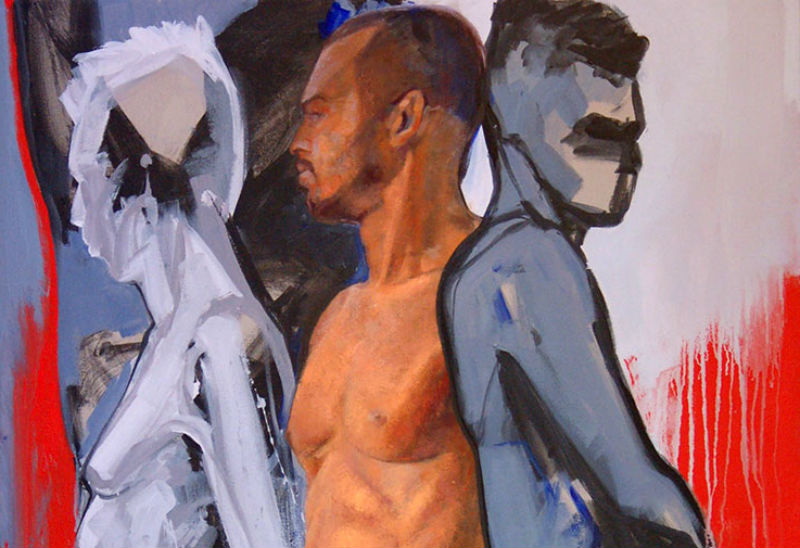Painted Drawings: Nora Venturelli's "Vice Versa" at WSG Gallery

Nora Venturelli has maintained a significant interest in figure drawing and painting throughout her career, and specialized in studying the human form in college. Her work addresses themes of movement, shadow, and the body in its relation to interior thought processes. These concerns are evident in her most recent work on display at WSG Gallery in an exhibit titled Vice Versa, which runs through June 10. In addition to her series on the human figure, Venturelli has worked with a number of other subjects, including landscapes and still life.
Venturelli was born in Rosario, Argentina, and emigrated to California in 1968 after graduating high school. Today, she teaches both drawing and painting at Eastern Michigan University and University of Michigan STAMPS School of Art & Design, and lives in both the United States and Argentina. She is active in the arts community, showing her work locally and internationally.
The selected pieces for Vice Versa include large-scale mixed-media paintings of the human figure in motion, with gestural lines and overlapping forms suggesting the trajectory of the body through space. Line and color combine to examine the physical body’s relation to human emotion. Also on display are charcoal figure-study drawings that employ similar gestural yet controlled line work to suggest dynamism, even if the figures are seated. Venturelli’s choice to show drawings and paintings alongside one another illustrate her growing concern with an integrated artistic approach in her work.
In fact, Venturelli set out to find an intersection between the gestural and linear qualities of her drawings and the style she had employed in her paintings. To do this, she began to incorporate these techniques by drawing with paint. Venturelli writes, “My approach to drawing with paint was triggered a few years ago when I realized that my drawings and paintings were not integrated. … This initiated a progressive morphing of my drawings into paintings with the objective that my paintings manifest the same gestural and linear characteristics as my drawing, and vice versa.”
In some works, it is unclear whether we see the same figure repeated in space, or if there are various bodies moving, or standing, together. This can be seen in the work Vice Versa, No. 43. In this example, two of three figures remain ambiguous with abstracted faces and bodies.

Throughout her work, Venturelli creates transparency where the modeled figure overlaps gestural sketches, disrupting the continuity of form. This common theme of forms overlapping other, finished figures is executed expertly in the piece Vice Versa, No. 35. In this work, a single female clearly repeats across the 6-foot canvas. The woman strikes a pose, and Venturelli captures it from different angles, using dimension, color, gesture, and layers.
Venturelli writes that a goal of her work is to show “human dynamics -- how we move, communicate, interact, and display ourselves, exposing and suppressing the layers and intricacies of our character. In this extensive body of work I document the passages of time, the fleeting moment.” Many of the fleeting moments represented are still, pensive, and others capture the figure in dynamic motion, representing the subject dancing across the canvas.
Venturelli’s figurative work recalls ideas presented in early modernism, such as in works by artists such as Marcel Duchamp, particularly Nude Descending a Staircase (No. 2). The exploration of time and space also seems to reference early photographic studies in motion, such as those by Eadweard Muybridge in 1872. However, her work goes beyond the study of movement and time, and creates intimate portraits of her subjects, capturing varying facial expressions and emotions. These emotive subjects contrast to the ambiguous, unfinished figures that surround and overlap the realistically-rendered focal points of the works.
Elizabeth Smith is an AADL staff member and is interested in art history and visual culture.
“Nora Venturelli: Vice Versa” runs through June 10 at WSG Gallery, 306 S. Main St. Exhibit hours are Tuesday-Wednesday, noon–6 pm; Thursday, noon to 9 pm; Friday and Saturday, noon-10 pm; and Sunday, noon–5 pm. For information, call 734-761-2287 or visit wsg-art.com/gallery.


































